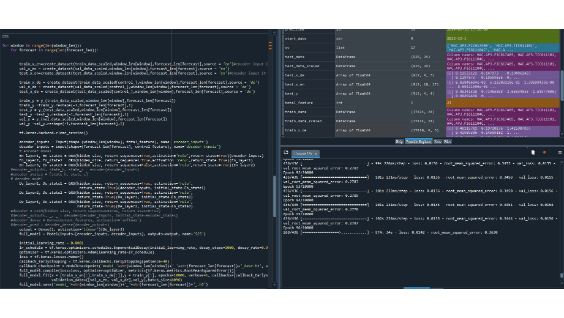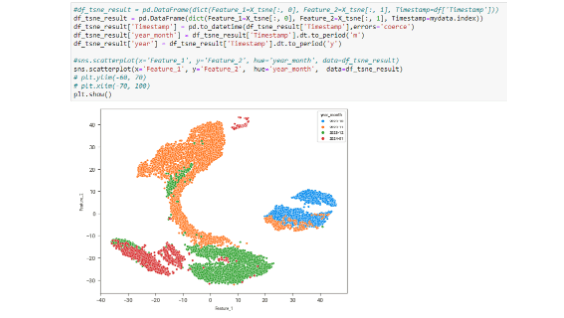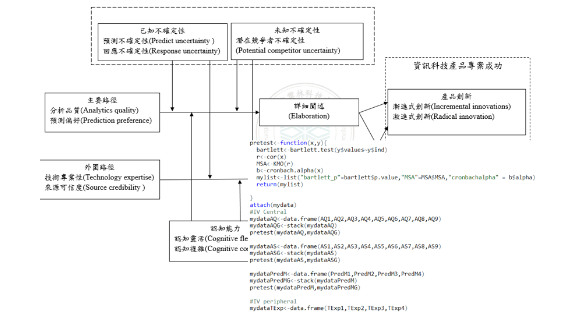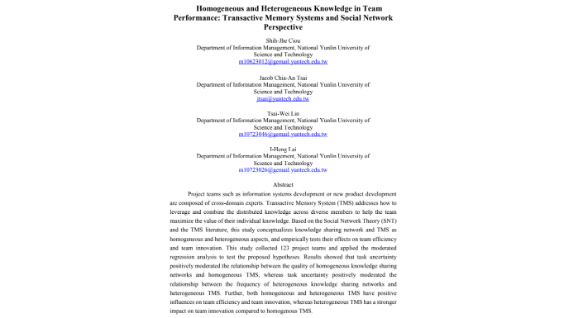
Tsai-Wei, Lin (林采薇)
I have expertise in Python, R, SAS, SPSS, and MySQL, majoring in Big Data Analysis and Market Decision-Making, with my research topic focusing on the development of a Big Data Decision Analysis Model for Project Managers. Currently, I am employed at Taiwan Chemical Fiber Co., Ltd., working as an AI R&D Engineer, and have accumulated three years of experience in AI application development in the chemical industry.
Taichung,TW
[email protected]
Competence
Data Analysis
- Design and Analysis of Experiments
(ANOVA, MANOVA, ANCOVA, and Repeated/Mixed ANOVA)
- Predictive Regression Analysis
(Liner Regression Analysis, Nonlinear Regression Analysis, and Logistic Regression)
- Multivariate Analysis
(Factor Analysis, Discriminant Analysis, and Cluster Analysis)
Programming
- Python
- R
- MySQL
- SAS
- SPSS
- Java
AI Algorithm
- Machine Learning
(Decision Tree, Random Forest,Support Vector Machine,K Nearest Neighbor,XGBoost,K-means Clustering,Isolation Forest)
- Deep Learning
(RNN,CNN,LSTM,GRU,Seq2Seq)
- Transfer Learning
- Ensemble learning
Certification
Project Management Assistant (PMA),2020 年 4 月
e-Enterprise Data Analyst-Big Data Process and Analysis,2019 年 6 月
Business Intelligence Data Analyst IBM SPSS Software Certificate,2019 年 5 月
Level B technician for computer software application,2014 年 4 月
Education & Expercise
Formosa Chemicals & Fibre Corporation,AI R&D Engineer,2020 / 9 ~
- 2020/9~2021/1 Developed a predictive model for stabilizing the activity control of reactors by implementing automatic control measures, thereby stabilizing reaction activity.
- 2020/9~2022/5 Worked on a project aimed at increasing reactor output, participating in forecasting and automatic control, which ultimately resulted in a 10% increase in production.
- 2022/3~2023/3 Established a monitoring module for the hydrogen purification unit, increasing hydrogen production by 0.7% and reducing equipment electricity usage by 4%.
- 2022/2~2023/2 Constructed a control model for a deaerator distillation unit to control steam usage under different loads, reducing steam consumption by 2% annually.
- 2023/1~2023/6 Performed offset anomaly analysis and unsupervised warning models for feed control valves, and built a system to identify key anomaly features.
- 2023/1~ 2024/2 Developed soft instrumentation for reactor temperature using transfer learning, ensuring production efficiency and safety.
National Yunlin University of Science and Technology - Master's Program in Information Management,2018 / 9 ~ 2020 / 8
- The Phi Tau Phi Scholastic Honor Society of the Republic of China in 2020
- Teaching Assistant for the Master's Program Data Analysis Course
- Teaching Assistant for the Undergraduate Statistics Course
- Data Analyst for the Ministry of Science and Technology project "The Impact of Team Knowledge Similarity and Diversity on the Performance of Information System Development Projects"
- Data Analyst for the Ministry of Science and Technology project "Reciprocal Behavior of Knowledge Seekers in Professional Communities"
- Industry-academic cooperation project with a well-known chain beverage manufacturer
- Published a conference paper "Shared and Differentiated Knowledge in Team Performance" at the 25th International Conference on Information Management and Practical Application
National Yunlin University of Science and Technology -
Bachelor's Program in Information Management,2014 / 9 ~ 2018 / 7
- Developed an R programming language teaching platform
- Authored course materials for statistical analysis classes
Projects

Hydrogen Purification Unit Monitoring Module
- Introduction:By predicting the CO content in future hydrogen production, we provide automatic control within specified ranges, saving 4% of compressor electricity annually, and also achieving a slight increase of 0.7% in hydrogen production per year.
- Analytical Methods/Tools:Utilized Python for variable selection through Wrapper Methods, and employed the Seq2Seq model for predictive model construction.

Control Valve Anomaly Diagnosis Module
- Introduction: By conducting cluster membership analysis, an early warning module is established to determine whether current operations fall within the range of past healthy conditions, and to alert the process that current operations may lead to control valve anomalies.
- Analytical Methods/Tools: Python is used for T-SNE dimensionality reduction to perform cluster membership analysis, and a K-Means unsupervised model is constructed.

Big Data Decision Analysis Model for Project Managers
- Introduction: The master's thesis focuses on developing a Big Data decision analysis model for project managers, aiming to explore how Big Data analytical reports can persuade project managers to make decisions.
- Analytical Methods/Tools: Employed R language for multivariate analysis and regression analysis.

Database Aggregation Analysis
- Introduction: Conducted an aggregation analysis of project management-related literature over the past ten years through database retrieval.
- Analytical Methods/Tools: Utilized MySQL to search for relevant data from academic databases and employed R language for aggregation analysis of the literature data.

Shared and Differentiated Knowledge in Team Performance
- Introduction: Based on the Social Network Theory (SNT)
and the Transactive Memory System literature, this study conceptualizes knowledge sharing network and TMS as
homogeneous and heterogeneous aspects, and empirically tests their effects on team efficiency
and team innovation.
- Analytical Methods/Tools: UCINET for social network analysis, and R language for data organization, multivariate analysis, and regression analysis.
